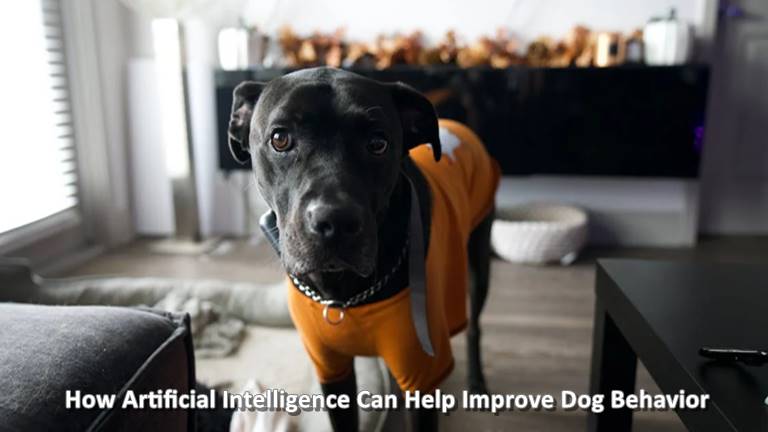Dogs are wonderful pets, but sometimes they exhibit problematic behaviors that can be challenging for owners to manage. Fortunately, artificial intelligence (AI) can provide assistance in improving dog behavior. AI technology can be used to identify problematic behaviors, monitor progress, and provide training recommendations. In this blog post, we will discuss how AI can help dog owners address their pets’ behavioral issues.
Identifying Problematic Behaviors
AI-powered tools can be used to detect problematic behaviors in dogs by analyzing their movements, sounds, and facial expressions. Cameras equipped with AI can detect when a dog is barking excessively, chewing on furniture, or engaging in other problematic behaviors. This information can help dog owners pinpoint the underlying cause of the behavior and develop an appropriate training plan.
AI tools can also help identify patterns in a dog’s behavior that may indicate an underlying health issue or emotional distress. For example, if a dog suddenly starts displaying destructive behavior, it may be a sign of separation anxiety or other emotional issues. By analyzing patterns over time, AI can help dog owners identify and address these issues before they become more serious. Additionally, AI-powered tools can provide feedback on the effectiveness of different training methods, allowing dog owners to adjust their approach and find the most effective way to modify their pet’s behavior.
Monitoring Progress
AI can also be used to monitor a dog’s progress during behavior modification training. Wearable devices can track a dog’s heart rate, body temperature, and activity levels, providing insight into how the dog is responding to the training. This information can help dog owners make adjustments to their training plan to ensure the best possible outcome.
AI-powered algorithms can analyze the data collected from wearable devices and provide insights on a dog’s progress over time. This can help dog owners and trainers identify patterns and trends in the dog’s behavior and make data-driven decisions about their training plan. The ability to monitor a dog’s progress in real-time and make adjustments based on data analysis can lead to more efficient and effective training, resulting in a better outcome for both the dog and the owner
Providing Training Recommendations
AI can provide customized training recommendations based on a dog’s specific behavior and personality. Apps and devices can suggest training exercises based on a dog’s age, breed, and behavior. They can also provide feedback on the dog’s progress and suggest how to improve their behavior. This personalized approach to dog training can help dog owners achieve better results and strengthen their bond with their pets.
In addition to personalized training recommendations, AI-powered dog training tools can also provide access to expert advice and support. These tools can connect dog owners with professional trainers and behaviorists who can provide guidance and feedback on their training progress. This can be particularly beneficial for dog owners who may not have access to local training resources or who need specialized expertise for their dog’s specific behavior issues.
Real-Life Examples
Several companies are already using AI to help dog owners train their pets. For instance, Furbo has developed an AI-powered camera that allows dog owners to monitor their pets remotely. The camera can also detect when a dog is barking excessively and send alerts to the owner’s smartphone.
Another example of AI being used to train dogs is through the use of smart collars. These collars can monitor a dog’s activity levels, sleeping patterns, and even provide real-time feedback to owners on their dog’s emotional state based on vocalizations and body language. This data can then be used to create personalized training plans for the dog and help owners better understand their pet’s behavior.
AI-Powered Training
AI can be utilized for training dogs, with the potential to create personalized training plans by analyzing a dog’s behavior and personality. The AI devices can adjust the training approach based on the progress of the dog. This positive reinforcement method can aid in teaching dogs basic obedience commands like sit, stay, and come. Additionally, companies are developing AI-powered devices that can teach dogs new skills, for example, to chase and catch a robotic mouse, while the device can use AI to adjust its behavior based on the dog’s movements.
Early Detection of Health Issues
AI can detect early signs of health issues in dogs by monitoring their vital signs and detecting any abnormalities. This can be especially helpful for older dogs or dogs with chronic health conditions. By detecting health issues early, dog owners can help their pets live longer, healthier lives.
AI can also help veterinarians diagnose health issues more accurately by analyzing medical data and providing insights that may not be immediately apparent to the human eye. This can lead to more effective treatments and better outcomes for the dogs. Additionally, AI-powered health monitoring devices for dogs are becoming increasingly popular, allowing pet owners to track their pet’s health and receive alerts if any abnormalities are detected. These devices can monitor a range of vital signs, including heart rate, respiratory rate, and temperature, and provide a comprehensive picture of a dog’s health over time.
Behavior Modification for Service Dogs
AI can be used to modify the behavior of service dogs, such as guide dogs or therapy dogs. By analyzing the behavior of service dogs in different scenarios, AI can suggest modifications to their training that can improve their performance and effectiveness. For example, if a guide dog is having difficulty navigating a certain environment, AI can provide suggestions for training exercises that can help the dog become more comfortable and confident in that environment.
Behavior modification for service dogs is an important aspect of their training, as their effectiveness directly impacts the quality of life of their owners. By utilizing AI-powered devices, trainers and owners can track the dog’s behavior in real-time, identify areas of improvement, and make necessary modifications to the training plan.
Moreover, AI can assist in training service dogs to perform new tasks, which can expand their abilities and improve the quality of life for their owners. AI-powered devices can break down complex tasks into smaller, more manageable steps, making it easier for dogs to learn and adjust to new tasks. This can lead to more efficient training and better outcomes for both the service dog and their owner.
Assistance in Dog Training Classes
AI-powered devices can also be used to assist trainers in dog training classes. Devices equipped with AI can monitor the behavior of multiple dogs at once and provide real-time feedback to the trainers. This can help trainers identify areas where their training approach may need to be adjusted and ensure that all dogs in the class receive personalized attention and training.
AI-powered devices can also provide visual aids and demonstrations to support trainers in their classes. For example, trainers can use devices to show dogs how to perform specific actions or behaviors, such as sitting or staying. This can be especially helpful for dogs that are visual learners or have difficulty understanding verbal commands. By incorporating AI-powered devices into their training classes, trainers can provide a more engaging and effective learning experience for both dogs and their owners.
Facilitating Communication between Dogs and Humans
AI can be used to facilitate communication between dogs and humans, especially for dogs that have difficulty communicating their needs or emotions. For example, AI-powered devices can translate a dog’s vocalizations or body language into human language, allowing owners to better understand their pet’s needs and emotions. This can improve the bond between dogs and their owners and make it easier to address any behavior issues that may arise.
AI can also be used to help dogs understand human communication better. For instance, AI-powered devices can be programmed to give verbal commands to dogs and provide positive reinforcement when they respond appropriately. This can help dogs learn human language more quickly and accurately, leading to better communication and stronger relationships between dogs and their owners.
Assistance in Finding Lost Dogs
AI devices can also be used to assist in finding lost dogs. Devices equipped with GPS and AI can track a dog’s movements and alert the owner if the dog has strayed too far from their usual route. This can help owners quickly locate their lost dog and bring them back home safely.
In addition to GPS tracking, AI can also analyze the dog’s behavior patterns and predict where they might go if they are lost. For example, if a dog has a habit of going to a certain park or visiting a specific neighbor, AI can suggest those locations as potential places to search. This can save time and resources when searching for a lost dog and increase the chances of a successful reunion between the dog and their owner.
Improving Animal Welfare
The use of AI in dog training and health monitoring has the potential to significantly improve animal welfare by providing personalized feedback and training plans. With early detection of health issues, AI can help dogs lead healthier, happier lives. Additionally, by improving communication between dogs and humans and facilitating more effective training, AI can strengthen the bond between pets and their owners, leading to more fulfilling relationships for both.
Moreover, the use of AI in dog care and training can lead to more efficient and effective use of resources, such as time and money. By reducing the need for trial-and-error approaches to training, AI can help trainers and owners make better use of their time and resources. This can ultimately result in better outcomes for the dogs and a more sustainable approach to animal care. Overall, the integration of AI into dog care and training can lead to a more proactive and personalized approach to animal welfare.
Limitations of AI in Dog Behavior Training
While the use of AI in dog behavior training has many potential benefits, it also has some limitations. One limitation is that AI is only as effective as the data it is trained on, meaning that if the data is biased or incomplete, the AI’s recommendations may not be accurate or effective. Additionally, AI may not be able to account for all of the nuances of a dog’s behavior and may miss important factors that a human trainer would be able to recognize.
Another limitation is that the use of AI in dog training cannot completely replace the role of human trainers. While AI can provide valuable insights and recommendations, it cannot replace the human touch and intuition that is often necessary in successful dog training. It is important for trainers to use AI as a tool to supplement their own expertise and experience, rather than relying on it entirely.
Final Thoughts
Artificial Intelligence has the potential to revolutionize the way we train, monitor, and interact with our dogs. By using AI-powered devices, dog owners can identify problematic behaviors, monitor progress, and receive personalized training recommendations. AI can also be used to detect early signs of health issues, helping dogs live longer, healthier lives. However, it’s important to remember that AI is not a replacement for human interaction and training.


